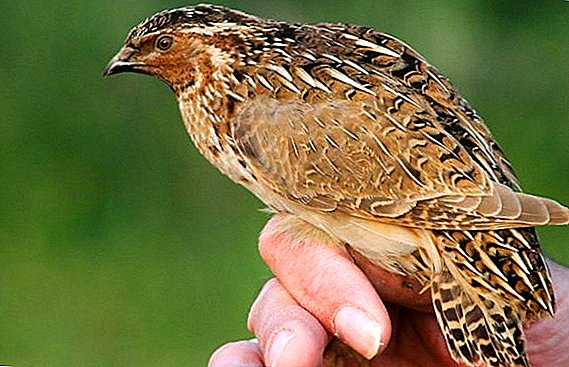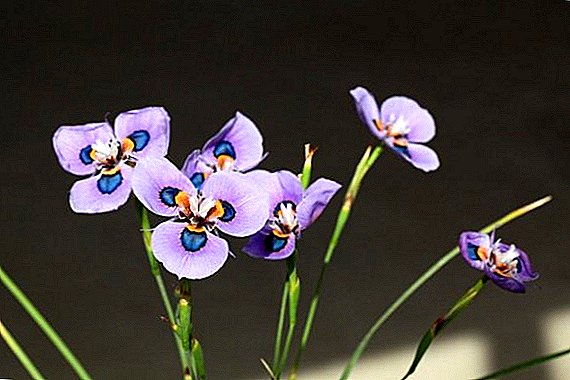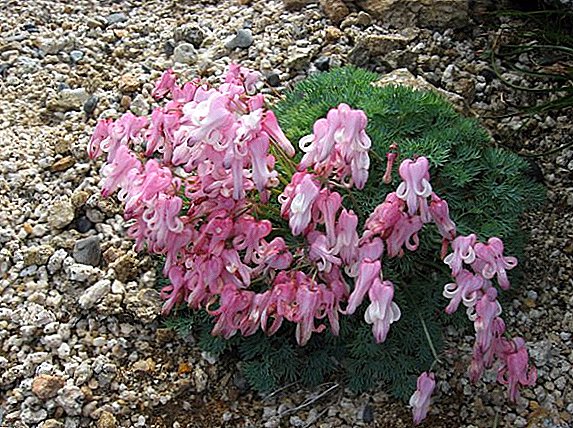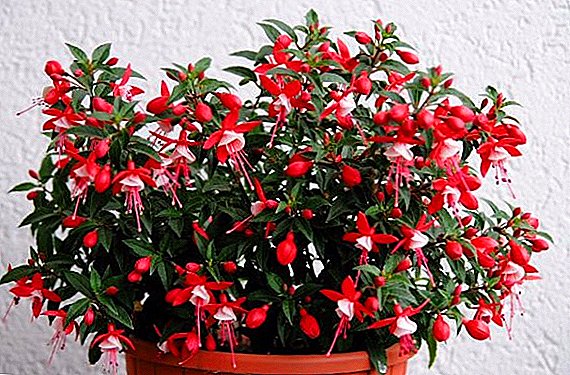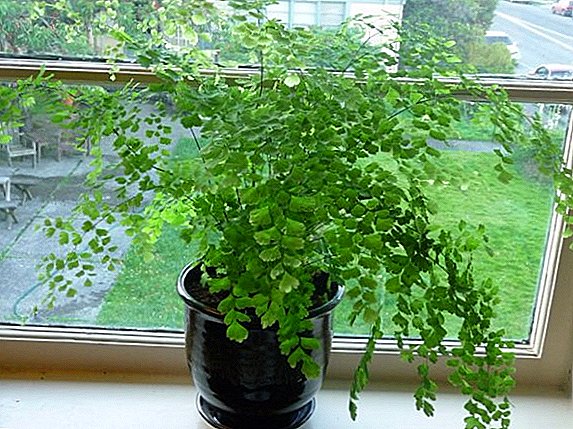 Maidenhair - A plant of extraordinary beauty, which is endowed with grace, not peculiar to other ferns.
Maidenhair - A plant of extraordinary beauty, which is endowed with grace, not peculiar to other ferns.
But in order for the flower to delight you and your loved ones, you will have to take care of it, and the adiantum is quite whimsical.
Description
If you are a little familiar with some species of ferns, then you will agree that adiantum is the most delicate and elegant plant from the whole range of ferns. Proof of this is the fact that this plant is often used by florists.
Did you know? Initially, the fern was used for wedding bouquets, as it is believed that it brings women happiness.

Although, of course, it is better to use the fern as a houseplant in pots, rather than decoration in bouquets. The fact is that the cut stalks wither very quickly: much faster than other components of the bouquet.
Patterned foliage looks very impressive, and its juicy bright green color will give your room freshness and summer mood even on the coldest winter day.
Adiantum is perennial fern. In height, it can reach 60 cm, and sometimes even higher. Root creeping and sprawling. Petioles are usually equal to an average of 13 cm. They have a glossy surface.
Devalia, asplenium, polynyadnik, pteris, pelleya, tsirtomium, platicerium, as well as adiantum, are among the most common types of ferns, represented mainly in the tropics and subtropics.
Room conditions
The lush green crown (photo of a fern below) will please the eye if you properly care for the plant. Care at home for adiantum requires diligence: you need to water, moisturize, spray, nourish and cut the fern. 
Humidity and temperature
Many plants do not pay attention to such factors as humidity, but this does not apply to adiantum. If you do not follow certain tips, then you can never achieve the effect of lush leaves and achieve a bright green color - and these are the main advantages of a fern.
Humidity should be high: not less than 60%, and it is better that this value reaches 70%. There are many ways to achieve this effect. Some in the house are damp enough, while others, on the contrary, have too dry air, and if you belong to the second category, you can spray the plant yourself.
High humidity needs to be maintained at any time of the year. 
Important! During the heating season, place the plant away from batteries and other appliances designed to heat the air.
Lighting
Adiantium care at home includes another important factor: lighting should be moderate, ideally diffused.
It is important to follow so that lady's hair there was no hot sun bright rays for him are destructive. It is better to choose a north or east window to place a pot with a flower.
If you still want the adiantum to be in the room from the south or west side, then in this case you should at least place it not by the window, but more deep into the room. Remove it from the outer wall at least three meters. 
In the spring, in the morning and in the evening, a small amount of sun is allowed; on a hot day, it is better to put a pot in partial shade.
In winter, additional lighting fern is not required.
The soil
The soil for this plant is suitable only certain, with a special composition. First you need to know that the fern pot should be spacious since it has a spreading root system.
Create an earthy mixture of the following components: leaf earth, peat. The best ratio for such components is one to one. 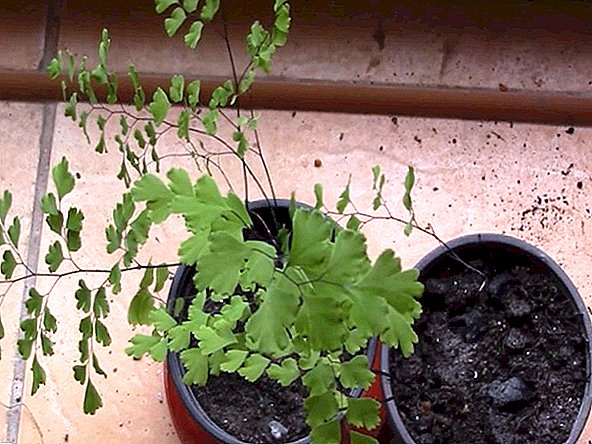
This is the best option for the presented type of plant. It is desirable, but not necessary, to add sand, calcium-containing fertilizer to the ground, as well as crushed coal, which was formed by burning wood.
During the care, constantly make sure that the soil at the root itself is loose, it should have high carrying capacity for water.
Adiantum landing
The plant propagates in two ways: division of the bush and disputes. You can choose yourself, we only tell you about the advantages and disadvantages of each of them in order to facilitate your choice.
Dividing bush
This option is better suited for breeding those ferns that are old enough, even so much that they have already lost their aesthetic qualities. 
Did you know? From the Latin name of the flower can be translated as "not getting wet." This name fern was due to the ability to remain dry even after exposure to water.This process should be approached with great care, because if something goes wrong, then you will not only not get new plants, but also completely destroy the old one. In addition, the rate of survival of the new parts is not very high.
Carry out the procedure in the spring. You need to get the fern from the pot carefully, along with the root. Next, the root is cleared of the land that remained on it, be careful not to tear the small roots. 
Prepare a sharpened knife, it is important that it is sterile. Carefully divide the rhizome into 2 or more parts so that each part has one (preferably more) healthy leaf.
Pre-sterilize the ground in advance, take some kind of container or pot, put some substrate there. In these containers, place the separated parts of the fern.
Important! After transplanting, immediately moisten the soil and fern leaves. Put the pots in a shady and warm place.By spraying, it is advisable to feed the roots. Care for young plants is the same as the care of adult specimens.

Do not worry, if the growth process takes too long, it is normal for a fern.
Disputes
Flower Venus hair can multiply in another way - spores. This option also has many difficulties. The temperature of the room should be about 22 degrees above zero.
Prepare the soil as stated above, be sure to add sand. Next, you need to find the largest and healthiest sheet. Below it will be small brown specks - this is the dispute.
This sheet should be separated from the plant, and collect all disputes from it. 
Important! DIn order to sterilize the soil, you can heat it in the oven or just in a frying pan.In the pot should be the substrate and drainage. Moisten the soil, and after that you can begin to sow. No need to bury spores, just sprinkle them on top of the ground. After that, you can sprinkle a little substrate on top and that's it.
Cover containers with cling film or some kind of glass to create a greenhouse effect. The room should be warm and dark enough, but when the first shoots appear, open the plants and transfer them to the light.
When, finally, the sprouts increase in size a little and harden, select the strongest ones and arrange the seedlings. There must be a minimum distance of 3 cm between each. 
Home care for the plant
Of great importance in the care at home for a venereal hair is watering and fertilizer. If the adiant leaves dry, it means that you didn’t perform these procedures carefully enough.
Watering
Water should not be too cold and not hot, it is better to take a liquid at room temperature.
Adjusting the temperature yourself is difficult, so to achieve this effect, hold the watering can with water for about an hour in the room. In addition, during this time she will have time to settle.
A very good option would also be the use of rainwater, which definitely will not have any harmful substances. 
No need to assume that this is tropical plant then it needs excessive watering. It is not, however, and no need to allow the land to be too dry. If you overdo it, you risk killing the entire aboveground part of the plant, and if you don’t use enough water, you can spoil the underground part.
In addition to the adiant tropical plants are also: cordyline, feijoa, nepentes, jacaranda (violet tree), aglaonema, clerodendrum, alokaziya, striped aechmea, humming and monstera.To know when it's time to water the flower, touch the soil with your hands. If it is a little dried, it means it's time.
Fertilizer
Venus hair is a flower that needs periodic feeding. Most often fertilize the soil with flower concentrate.
You can pick up any dressing recommended at the pet store. The flower is not picky in this matter. Fern fertilizer will have to be produced during its growing season.
As you know, it lasts from a plant in spring, as well as summer time. Perform the procedure about 1 time in 20-30 days. 
Transfer
Transplantation, like bush reproduction, division or spores, takes place exclusively in spring. Gardeners note that the best result is achieved if do it annually. If you do not have enough time or desire, then a transplant is allowed only when you understand that in a pot the fern has become cramped.
The rules are exactly the same as for fern breeding:
- Sterilize the ground.
- Remove the plant from its past habitat.
- Carefully clean the root from the ground.
- Put in a new pot.
- Immediately moisten the ground and spend feeding.

Pests, diseases and other difficulties
Care at home for venereal hair is not limited to watering and fertilizer, it is important to ensure that the plant does not get sick. Although it’s not worth worrying about it (the fern rarely attacks pests), you still need to know about the possible dangers.
If you notice that the leaves closer to the beginning begin to turn yellow, and further along the length become brown, then these are signs that the plant is sick because of drafts, lack of watering or because of insufficiently moistened air.
In this case, you need to take the following measures: close the window near the flower or take the pot away from them, monitor the moderation of watering and remove the flower away from the batteries. 
If the leaves are almost completely yellow and only slightly brown closer to the end, then dry air is to blame. In such conditions, the flower will not give new shoots.
Surprisingly, but if you find blanching of the leaf, it will mean that it is time to remove the flower away from the light.
To accelerate growth too slow fern, increase the dose of fertilizer.
Did you know? In Croatia, as well as in Canada, the fern is protected, as it is considered an endangered plant.

When the root system starts to rot, the first call to this process will be a listless leaf, despite the fact that the soil will still remain wet. In order not to aggravate the problem, you need to dry the soil and no longer allow uneven irrigation.
But if the root has already begun to rot and the process is irreversible, you will have to remove the damaged areas and transplant the flower to a new place.
When you start to notice that the tips of the leaves begin to twist, then it is time to create more comfortable living conditions for the adiantum - it is cold.
Due to too salty soil, leaves may become covered with brown spots. In this case, you can just replace the earth with another.
One of the possible pests that can attack a plant is thrips. You will notice that they appeared when you find that the leaves become bronze. Alas, the fern cannot be cured. Destroy the plant otherwise, the virus that is spread by thrips will go on.
As you can see, caring for a gentle and elegant fern requires some effort. But agree that they are all worth it in order to enjoy the beautiful flowering of adiantum.


